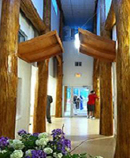
|
|
Maharishi University of Management makes sustainability its focus As our planet is faced with more and more problems related to finite resource depletion, pollution, and climate change, we’re forced to examine everything in our daily lives that makes an impact on the earth. The buildings we live and work in are a huge part of this—both the most basic means of shelter for our survival as well as the source for our greatest consumption of resources. From the materials used to build and maintain homes to the utilities needed to power them, we take a lot from the earth in order to live day to day. We don’t often think about how building practices affect the environment, but we do notice when where we live influences our health and quality of life. Many conventional building practices operate without regard to either of these factors, at the expense of our health and the health of the world. •In the U.S., buildings are responsible for 39% of our total energy use and 72% of our electricity use(1) alone. They also account for 13% of consumptive water use in the U.S. Every day, Americans use an average of 100 gallons of water (2), with significant energy spent for heating, pumping, and treating this water for home use. Resources: There is a way to build comfortable residential and commercial buildings while mitigating the toll on human and environmental health. It’s called green building, or sustainable building. Rather than replacing conventional building practices, green building methods simply supplement healthier and more efficient materials and strategies throughout the construction process. The EPA provides this definition: “Green building is the practice of creating structures and using processes that are environmentally responsible and resource-efficient throughout a building’s life-cycle from siting to design, construction, operation, maintenance, renovation and deconstruction. This practice expands and complements the classical building design concerns of economy, utility, durability, and comfort. Green building is also known as a sustainable or high performance building.” More and more architects and builders, as well as renters and homeowners, are turning to green building for a system that can better sustain itself, benefitting the individual as well as the environment. The process of green building takes into account all impacts of the built environment, including consumption, environmental effects, and overall effects on the occupant and world. Some ways in which green building works to improve on conventional construction include: •Using recycled or reclaimed wood, non-toxic insulation, and other healthier and more sustainably produced materials during construction. To make green building the norm in the construction industry, and to start seeing changes in the health of people, communities, and the world, we need more people to learn and practice sustainability and green building principles. Whether its an education in architecture, construction, landscaping, or city planning, we can strengthen a system that takes sustainability into account at every step of the process. Only with a conscious awareness of human and environmental health can we move forward in repairing the damage that’s already been done by creating better built environments. If you want to make a change to the buildings you and your community live in, you can take part in making this industry sustainable. Maharishi University of Management (MUM) has made an education in sustainability their focus. They offer classes in green building and implement the same sustainable principles in their own campus buildings, because they believe this is where the future of our living environment is going. MUM wants to enable individuals to be pioneers in this field, making real and lasting changes to the buildings used for life, work, and play. COURSES AT MUM At MUM, all the Sustainable Living BA students are required to complete a set of core courses, which provide a solid base for further study. Students then have the option of picking a specific track of focus, such as our Sustainable Building track. Building on the fundamentals of sustainability gained from core courses, the four courses in the Sustainable Building track give students practical experience in the newest methods, materials, and design philosophies of “green” construction.
© Copyright 2016 Maharishi University of Management
|
|

